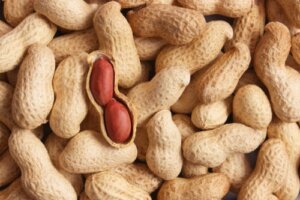Eating Peanut Skins: Everything You Need to Know


Written and verified by the nutritionist Maria Patricia Pinero Corredor
Peanuts are one of the most appetizing snacks and, for this reason, a great diversity of products containing them have been introduced onto the market. However, encouraging people to consume peanut skins hasn’t been easy, since the industry eliminates this part of the nut.
The most common form of presentation is completely peeled and with a lot of salt, regardless of the antioxidant properties of its reddish shell. The peanut skin is a by-product considered of low value, so it’s discarded or used for animal feed.
However, it does contain benefits. For example, it provides phenolic compounds that promote health. In this article, we invite you to learn more about the advantages of eating peanut skins.
What is a peanut?
Science gives the name Arachis hypogaea to the peanut. Although it has been considered a nut because of its woody shell, it’s actually a legume. It’s related to peas, lentils, chickpeas, and beans, among others.
As a seed of the legume group, it develops covered by a capsule, called a pod, or shell. In a whole peanut, the shell represents around 30%, the seed around 70% and the skin between 3 and 3.6%.
It’s cultivated on all continents and is native to South America. Most of it is produced in Asia, Africa, South America, and North America
It’s the sixth most important oilseed crop in the world, due to its richness in fat. According to the Food and Agriculture Organization of the United Nations, it’s important due to its nutritional value, being useful as a source of oil and vegetable protein.

Nutritional properties
The peanut kernel is nutritious. It contains 44 to 54% fat. Its protein is 2.7 times higher than in beef and up to 16 times higher than in milk.
Its biological value is lower than that of animal protein, as it lacks several essential amino acids. However, 90% is digested without difficulty.
It also contains carbohydrates of different types, including 3% fiber. Sucrose and starch account for most of them, with a low glycemic index.
It also stands out for its vitamin E, B complex, pantothenic acid, and folic acid content. On the other hand, peanuts are one of the richest seeds in niacin, providing 16 milligrams per 100 grams (4 oz) of the product. Roasting increases its concentration.
Peanuts provide zinc, phosphorus, potassium, and magnesium. The richness in oil makes it used for the production of peanut butter, candies, snacks, and as a diluent for meat products, soups, and desserts.
Bioactive compounds in peanut skins
An estimated 35 to 45 grams (1.5 to nearly 2 oz) of peanut skin is produced per kilogram (2.2 pounds) of shelled peanut kernel. Most varieties have a pink or red skin color.
Many of the pigments are of the flavonoid type, such as anthocyanins. Phenolic compounds are also found in higher concentrations than in green tea, which are concentrated when the peanut is roasted or toasted.
According to several specialists, among the phenolics are chlorogenic acid, caffeic acid, coumaric acid, ferulic acid, and stilbenes, such as resveratrol (which is also contained in grapes). All of them have antioxidant activity; not only by trapping free radicals, but also by their reducing power.
Resveratrol and flavonoids are the most active in peanuts and prevent some diseases. They’re present throughout the peanut, from the root to the skin, and even the shell.
Peanut skin extracts are considered potential sources of natural antioxidants.
Resveratrol
Resveratrol is an antioxidant polyphenol that was studied for its protective role against heart disease, degenerative diseases such as Alzheimer’s, systemic inflammation and cancer.
The resveratrol content of peanuts is similar to that of grape juice, being 3 times higher when peanuts are roasted with the skin. Although more studies are needed, some authors reveal that the substance acts as a chemopreventive agent against several types of malignant tumors.
Phenolic acids and flavonoids
Peanuts and their skins are exceptional sources of functional compounds, such as phenolic acids. In particular, they have high levels of p-coumaric acid, which increases the total antioxidant content by up to 22%. In addition, roasted peanut skins have a higher antioxidant capacity than roasted peanuts without the skin.
High intakes of flavonoids are also believed to protect against heart disease and cancer. The types of flavonoids are the same as those found in green and black tea, apples, red wine, and soybeans.
In other words, by eating peanuts with the skin on you can get more antioxidants. Some studies show that by adding between 0.5 and 2.5% of the skin to a food product, the antioxidant capacity of the food increases by 30%, without modifying its acceptability.
Caution with peanut consumption
Despite the health benefits of peanuts and their use as a functional ingredient, consuming them with the skin doesn’t diminish their allergenic power. Certain precautions should be taken, especially if it’s the first time you do it.
It seems that arachin and conarachin proteins were found to be the main allergens of the different peanut kernels. These are concentrated in the seed and not in the skin. They’re related to the action of immunoglobulin E and other histamine-releasing anaphylatoxins.
Allergy symptoms may include the following:
- Vomiting
- Diarrhea
- Anaphylactic shock
- Urticaria and eczema
- Bronchospasm and asthma
- Inflammation of lips, face, and throat
Another potential problem to be aware of is food poisoning, as the product is often contaminated with the fungus Aspergillus flavus, which can produce toxic aflatoxin.

Should I eat peanut skins?
Peanuts are a great source of nutrition and are a healthy ingredient for the entire population. The peanut skin is a resource to obtain polyphenols and contribute positively to health.
In this regard, the marketing of peanut products with the skin on should continue to be supported, as it provides a high content in antioxidant compounds, such as resveratrol.
It’s recommended to roast them in the oven for 10 minutes to increase the antioxidants in the skin. If possible, the roasted skin should also be used to add to other preparations, such as soups or smoothies. In this way, we increase the intake of dietary fiber.
All cited sources were thoroughly reviewed by our team to ensure their quality, reliability, currency, and validity. The bibliography of this article was considered reliable and of academic or scientific accuracy.
- FAO (Organización de las Naciones Unidas para la Alimentación y la Agricultura). 2020. FAO: Perspectivas por sectores principales. Producción de cultivos (en línea). Consultado 29 oct. 2020. Disponible en http://www.fao.org/3/y3557s/y3557s08.htm#TopOfPage.
- Vollmann, J; Rajcan, I. 2009. Oil Crops y Peanuí. London New York. Primera edición. Springer (ed). 548 p. ISBN 978-0-387-77593-7. Disponible en: https://www.springer.com/de/book/9780387775937
- Al-Khayri, JM; Jain, SM; Johnson, DV. 2019. Advances in plant breeding strategies: nut and beverage crops y Peanut (Arachis hypogaea L.) breeding. Primera edición. Cham, Switzerland. Springer Nature Switzerland AG (ed). 573 p. ISBN 978-3-030-23111-8. Disponible en: https://vdoc.pub/documents/advances-in-plant-breeding-strategies-nut-and-beverage-crops-volume-4-4tram5cfov30
- Arya, S. S., Salve, A. R., & Chauhan, S. (2016). Peanuts as functional food: a review. Journal of food science and technology, 53(1), 31–41. https://doi.org/10.1007/s13197-015-2007-9
- Rudolf JL, Resurrección AV. Obtención de resveratrol en granos de maní mediante la aplicación de estrés abiótico. J Química alimentaria agrícola. 2006; 53 :10186–10192. doi: 10.1021/jf0506737.
- Juan ME, Vinardell MP, Planas JM (2002) La administración oral diaria de dosis altas de trans-resveratrol a ratas durante 28 días no es dañina. The J Nutr 132(2):257–260 . Disponible en: https://pubmed.ncbi.nlm.nih.gov/11823587
- Chen SIRTI proyecta contra la toxicidad de amiloide-b dependiente de microglía mediante la inhibición de la señalización de NF-kB. J Biol Chem. 2005; 280 (48):40364–40374. doi: 10.1074/jbc.M509329200. Disponible en: https://pubmed.ncbi.nlm.nih.gov/16183991
- Gagliano N, Aldini G, Colombo G, Rossi R, Colombo R, Gioia M, Milzani A, Dalle-Donne I. El potencial del resveratrol contra los gliomas humanos. Medicamento contra el cáncer. 2010; 21 : 140-150. doi: 10.1097 / CAD.0b013e32833498f1. Disponible en: https://pubmed.ncbi.nlm.nih.gov/20010425
- Delmas D, Lançon A, Colin D, Jannin B, Latruffe N (2006) El resveratrol como agente quimiopreventivo: una molécula prometedora para combatir el cáncer. Curr Drug Targets 7(4):423–442. Disponible en: https://pubmed.ncbi.nlm.nih.gov/16611030
- Lopes RM, Agostini-Costa TDS, Gimenes MA, Silveira D (2011) Composición química y actividades biológicas de especies de Arachis. J Agri Food Chem 59(9):4321–4330. Disponible en: https://pubmed.ncbi.nlm.nih.gov/21425852
- Francisco ML, Resurrección AV. Componentes funcionales en maní. Crit Rev Food Sci Nutr. 2008; 48 (8):715–746. doi: 10.1080/10408390701640718. Disponible en: https://pubmed.ncbi.nlm.nih.gov/18756396
- Adriano Costa de Camarg, Carolina Maldonado Martins Vidal, Solange Guidolin Canniatti-Brazaca, Fereidoon Shahidi. Fortification of Cookies with Peanut Skins: Effects on the Composition, Polyphenols, Antioxidant Properties, and Sensory Quality. J. Agric. Food Chem. 2014, 62, 46, 11228–11235. https://doi.org/10.1021/jf503625p
- Achar PN, et al. Estudios microscópicos sobre granos de maní comerciales infectados con Aspergillus flavus en Georgia. Ecotoxicol Environ Saf. 2009; 72 :2115–2120. doi: 10.1016/j.ecoenv.2009.04.002. Disponible en: https://pubmed.ncbi.nlm.nih.gov/19443032
This text is provided for informational purposes only and does not replace consultation with a professional. If in doubt, consult your specialist.








